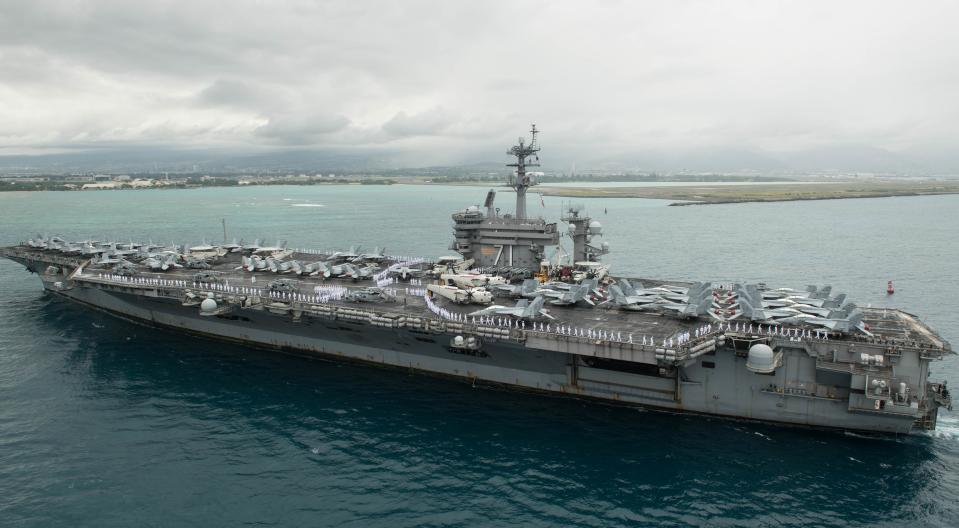One in 10 sailors on coronavirus-stricken aircraft carrier tested positive
WASHINGTON — Roughly 10 percent of sailors from the USS Theodore Roosevelt aircraft carrier have tested positive, the Navy announced Wednesday.
Meanwhile, one crew member from another aircraft carrier, the Nimitz, preparing to put to sea, in Bremerton, Wash., has tested positive and another is suspected of having the disease, although only the latter spent time on the ship after possibly contracting the virus.
According to the Navy, 93 percent of the Theodore Roosevelt’s roughly 4,800 crew members have been tested for COVID-19, the disease caused by the coronavirus. Those tests have so far yielded 286 positive results and 2,588 negative results, the Navy announced. Those numbers mean that so far roughly 10 percent of those who have received results have tested positive for the disease, with more than 1,900 sailors either yet to be tested or awaiting results.

As of Wednesday, 2,329 sailors had moved ashore in Guam. The Navy has been working with the local authorities there to gain access to hotel rooms in which sailors can be quarantined. However, only those with negative test results are allowed to stay in the hotel rooms.
“Sailors will only be permitted to depart Naval Base Guam following a negative COVID-19 test result and they must remain in quarantine in their assigned hotel rooms for the duration of the mandatory 14-day period,” said Cmdr. J. Myers Vasquez, a spokesman for the Navy’s Pacific Fleet in an emailed response to questions from Yahoo News. “As testing continues, the ship will keep enough sailors on board to sustain essential services and sanitize the ship in port.”
None of the crew’s COVID-19 cases have required hospitalization, according to the Navy.
One of the Theodore Roosevelt sailors to test positive was its former commanding officer, Capt. Brett Crozier, whose decision to send an urgent memo up his chain of command expressing concerns about the pace of the Navy’s response to the COVID-19 outbreak on his ship cost him his job. Then-acting Navy Secretary Thomas Modly relieved Crozier for putting too many people on the “cc” line of his email containing the memo. Modly resigned Tuesday after coming under intense criticism for a speech he gave Monday to the Theodore Roosevelt crew in which he was harshly critical of Crozier.
How long the Theodore Roosevelt will remain in Guam is unclear, but the standard quarantine period is 14 days. The carrier arrived in Guam around March 27.
Meanwhile, the Nimitz is hoping to avoid a similar outbreak this spring. After a sailor from the Nimitz contracted COVID-19 on a trip to see his family and was ordered not to return to the ship, another sailor on board the ship began exhibiting symptoms of the disease within the last two weeks, according to Cmdr. Ronald Flanders, a spokesperson for U.S. Naval Air Forces. Test results on the second sailor were “inconclusive,” but the sailor was removed from the ship and isolated as a precautionary measure, Flanders said.
“Sailors that had been in close contact with the individual were also removed from the ship as a precaution and placed into quarantine,” Flanders added.

The cases involving the Nimitz were first reported by Politico.
The Nimitz’s home port of Bremerton is in Washington state, where the first COVID-19 case in the United States was confirmed on Jan. 21. By April 6, the state had 8.682 confirmed cases, of whom 394 had died.
The Navy has embarked the carrier’s full-time crew of about 3,000 sailors in an attempt to safeguard them from the virus that has spread around the state. “No one goes on the ship each day without being asked a set of questions,” said Flanders. “If they have traveled to a high-risk area or if they feel ill in any way they are vectored away.”
Sailors also have their temperature taken before boarding the ship, and anyone running a fever is placed in isolation, according to Flanders.
Once the crew members are aboard, they are expected to follow all the now familiar Centers for Disease Control and Prevention guidelines about frequent hand washing and social distancing “to the greatest extent possible,” said Flanders. “It’s difficult to practice aboard a fully manned warship,” he added.
_____
Click here for the latest coronavirus news and updates. According to experts, people over 60 and those who are immunocompromised continue to be the most at risk. If you have questions, please refer to the CDC’s and WHO’s resource guides.
Read more:



